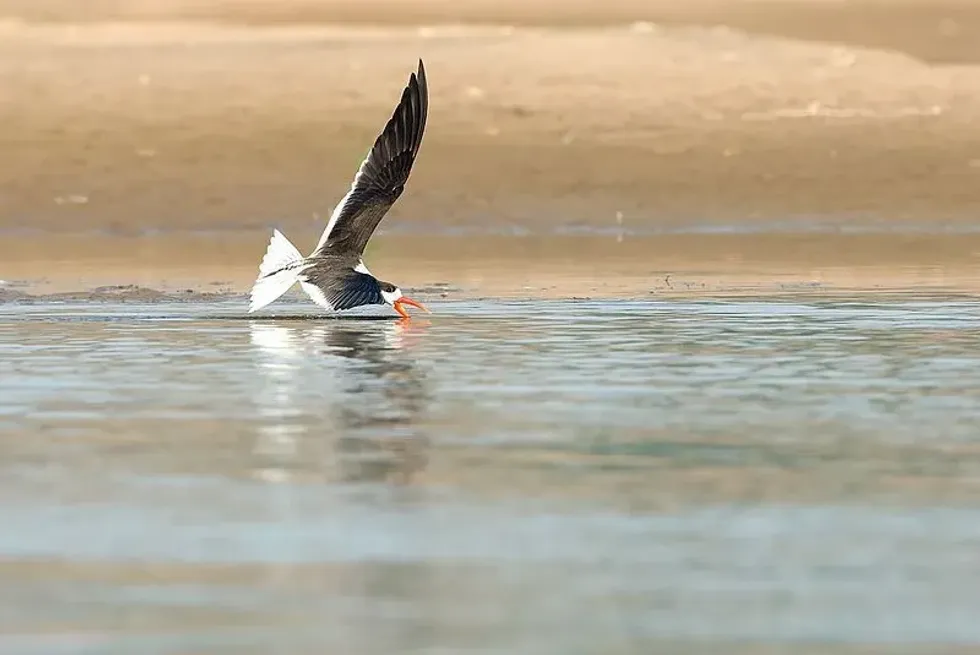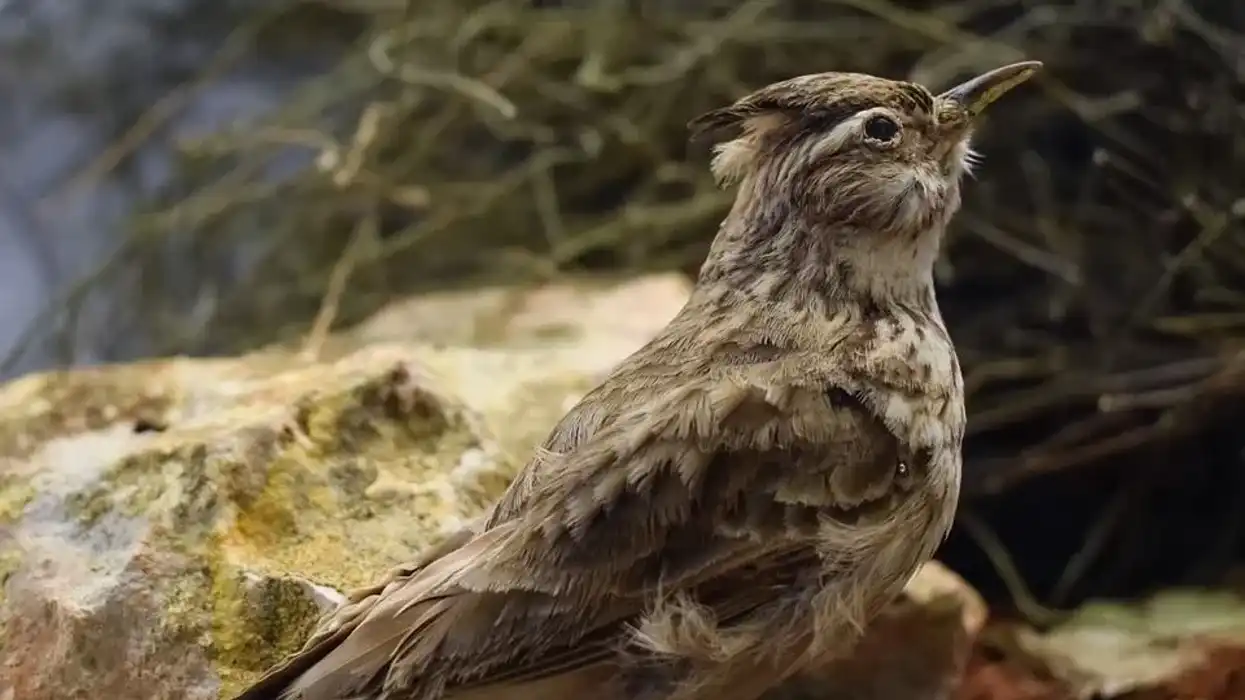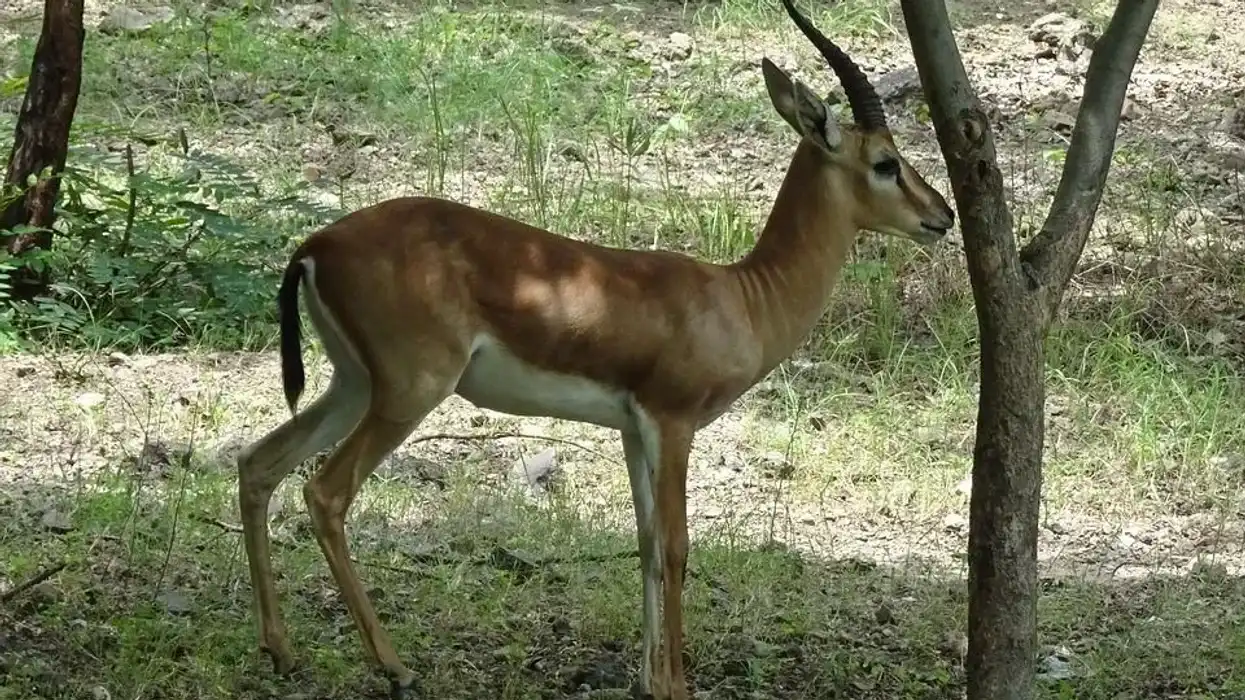The Indian skimmer (Rynchops albicollis) is an endangered bird from India. Apart from India, they could be found in the neighboring countries as well as in Africa.
The species have a unique long lower mandible with a white trailing edge on their wings along with the white central feathers.
The habitat of the population includes the rivers of India, where the pairs lay 3-5 eggs yearly. The incubation period lasts for around 21-30 days, where the eggs are kept in the nest during the cooling times of the day and are shifted to cooler areas during the hotter parts of the day.
The African skimmer and the Indian skimmer are equally threatened (Vulnerable) and are preserved in the National Chambal Sanctuary, which is a wildlife sanctuary, mainly to protect them from the degradation of water bodies.
The Indian skimmer male bird is almost similar to the female but is considerably bigger. The breeding species are comparatively brighter and prettier than the non-breeding ones.
If you like this, you might want to know about the Australian pelican and Sarus crane.
Indian Skimmer Interesting Facts
What type of animal is an Indian skimmer?
The Indian skimmer (Rynchops albicollis) is a bird. Belonging to the family Laridae, with genus Rynchops, the skimmer is mostly a winter bird.
What class of animal does an Indian skimmer belong to?
The Indian skimmer bird (Rynchops albicollis) belongs to the Aves class of animals like the African skimmer. They are a member of the species with the phylum Chordata.
How many Indian skimmers are there in the world?
According to the data, T
the Indian skimmer (Rynchops albicollis) is listed under the Endangered category by the International Union for Conservation of Nature and Natural Resources (IUCN) red list. There has been an estimated population of around 2,500-3,000 individuals currently distributed across the India-Vietnam border and around 6000-10000 individuals in India and its neighboring countries collectively.
Where does an Indian skimmer live?
The Indian skimmer (Rynchops albicollis) is a bird mostly spread across India during the winter. During this time, the birds are found in the sandy lowlands and marshes. During the non-breeding period, they are found in estuaries and coasts.
These birds are strictly restricted towards the coastal region of the eastern and western parts of India. Apart from India, the birds are seen in different parts of Bangladesh and Pakistan. Few Indian skimmers are also found in the central parts of Africa as well.
What is an Indian skimmer's habitat?
The Indian skimmer (Rynchops albicollis) habitat range map includes the coastal wetlands, the lagoons along with large lowland rivers and lakes, marshes, swamps, and freshwater areas, mostly during the breeding season. They are distributed in colonies that have a habitat of an open sand bar and a large sandy island surface.
The nest is mostly spotted in the sand-filled islands or near the open sand banks.
During the non-breeding period, they are found in estuaries and coasts. There have a tendency to shift the habitat during the breeding season to search for proper food and shelter.
Who do Indian skimmers live with?
Indian skimmers are monogamous beings and are seen to live pairs in the colonies along the large rivers and lakes. The birds are hardly alone and are mostly found in groups along with other birds like the terns, usually during the breeding season.
How long does an Indian skimmer live?
A native to the Chambal river of South Asia, the Indian skimmers have a longer life span. They have an average life span of around 15-20 years. Although when the birds are kept in places like the National Chambal Wildlife Sanctuary, they are known to have a longer and better life.
How do they reproduce?
Indian skimmers are monogamous birds of India and mostly stay in pairs. Skimmers are known to breed only once a year.
During the breeding season, around 40 mating pairs are seen in the breeding colonies. The colonies are mainly along the banks of the Chambal river with nests of other birds like terns.
The nest is built on the ground to avoid disturbance from the predators and protect the nest. The breeding season happens between February to May, where the Indian skimmer female lays 3-5 eggs.
When the chicks are born, the central feathers are mainly brown, while the shoulder feathers are black. The chicks have a short forked tail along with an orange bill with a yellow tip.
At the time of birth, their bill is of the same size, but by the age of 35-42 days, they develop a longer lower mandible. The young birds attain sexual maturity by the time they are two years old.
What is their conservation status?
According to the International Union for Conservation of Nature and Natural Resources (IUCN), the Indian skimmer birds are an Endangered species currently with an average individual of around 2,500-3,000.
There has been a declining slope in the population trend as the birds were threatened by the excess amount of degradation along with disturbance and pollution of the large rivers and lakes. The degradation of water bodies due to the irrigation schemes causes disturbance to the breeding areas of the birds.
Currently, the birds are preserved in the National Chambal Sanctuary, where the breeding colonies were free and unprotected.
Indian Skimmer Fun Facts
What do Indian skimmers look like?
The Indian skimmer (Rynchops albicollis) is a vibrant species of the Laridae family. The skimmers have some distinctive features like a black head and a white face. It has a prominent long, thick, and broad bill.
The long, thick, and broad bill is a bright orange-colored bill with a distinctive yellow tip. The wings are long and black and have a white trailing edge. They have a short forked tail with a pair of reddish feet.
How cute are they?
Needless to say, a native to South Asia, these species are extremely cute by their appearances. The vibrant colors like orange, yellow, and white central plumage make them look appalling and are a delight to the eyes of the visitors.
How do they communicate?
Indian skimmers are mostly silent birds are known to live in harmony. In cases of danger, to warn the members, their behavior changes, and they emit 'kyap-kyap' or 'kap' or 'kip' notes. The notes are mostly emitted when the birds are in flight or when they are disturbed.
How big is an Indian skimmer?
The Indian skimmer (Rynchops albicollis) species have an average weight of around 0.8 lb (350 g) and have a height of around 15.7–16.9 in (40–43 cm), which is similar to the size of the black skimmer.
How fast can an Indian skimmer fly?
With a wingspan of around 42.5 in (108 cm), the species are known to be great fliers. The speed helps them to be quick and prey on insects and flies. The flight helps them to catch fish from the lakes as well.
How much does an Indian skimmer weigh?
The beloved little Indian skimmer is known to have a weight of 0.8 lb (350 g) on average.
What are the male and female names of the species?
There is no specific name assigned to male and female members. They are usually referred to as the sex that the individual belongs to.
What would you call a baby Indian skimmer?
Baby Indian skimmers are mostly known as chicks.
What do they eat?
They are carnivores and mostly feed on aquatic fish. Apart from fish, the species feed on insect larvae and crustaceans. The long lower mandible helps them to catch fish from the oceans.
Are they poisonous?
There has been no information about these species being poisonous in nature.
Would they make a good pet?
Being a bird of the wild, they are not considered to be a good pet to humans. Being a vulnerable species, they are mostly kept in sanctuaries or estuaries by humans to preserve and protect them.
Did you know...
Only the skimmer is known to have a type of physical protection of extended eyes like slits while skimming. Skimmers are the only ones to have such protection against the water spray while skimming through the water surface.
They show aerobatic skills while it flies steadily through the upper layer of the water bodies.
What's unique about an Indian skimmer?
Skimmers have a unique orange bill with a yellow tip on it that helps in identifying them. The bill has a unique feature. It has a longer lower mandible. The orange bill helps the birds to pierce the fish through the surface of the lakes and streams as the upper portion is quite flexible.
Is the Indian skimmer a migratory bird?
Skimmers are partially migratory. They only migrate from the coastal areas during the breeding season towards a sandy open area in search of protected shelter and proper food.
Here at Kidadl, we have carefully created lots of interesting family-friendly animal facts for everyone to discover! For more relatable content, check out these giant cowbird facts and ani bird facts for kids.
You can even occupy yourself at home by coloring in one of our free printable bird coloring pages.
Main image by Koshy Koshy.
Second image by Wildmishra.









